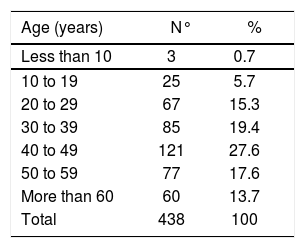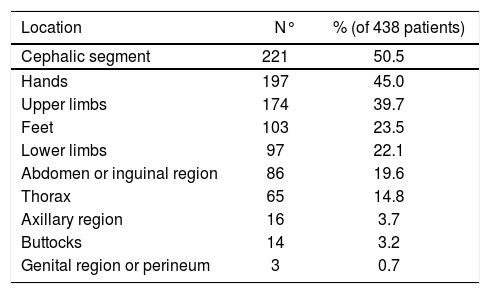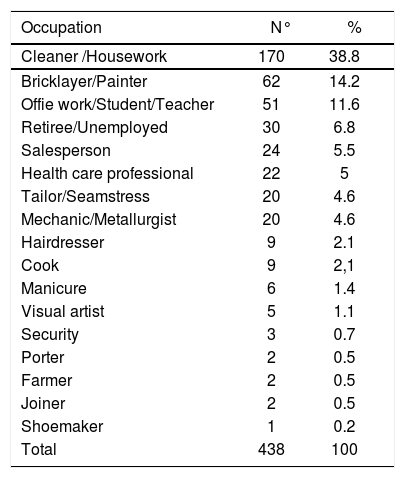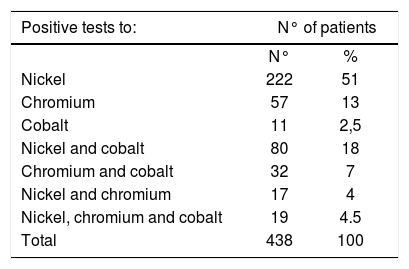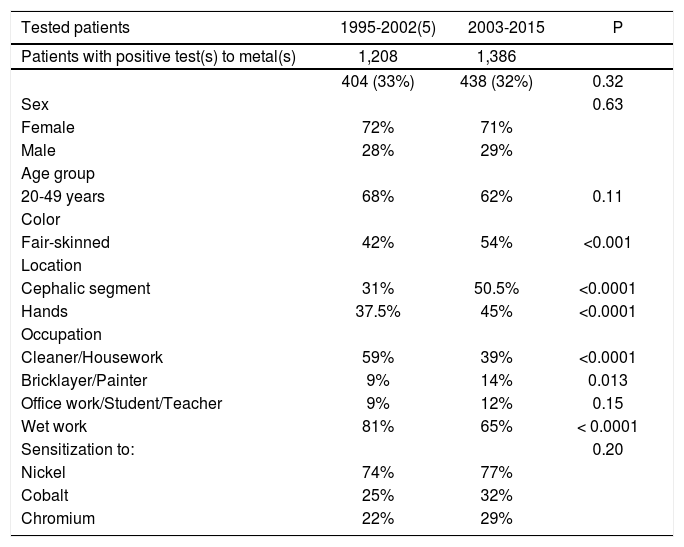Metals are common agents of allergic contact dermatitis, occupational or not, with decreasing incidence over the last years in some countries that have regulated the amount of nickel in objects.
ObjectivesTo analyze and compare with previous studies the profile of metal sensitization between 2003-2015.
MethodsPatients who underwent patch testing between 2003-2015 were evaluated retrospectively regarding the sensitization rates to metals, the associations between them, the relationship with profession and epidemiology.
ResultsOf the 1,386 patients tested, 438 (32%) had positive test to some metal, similar results to the 404/1,208 (33%) of the previous study (1995-2002) performed at the same service (p=0.32). The frequency of nickel (77%), cobalt (32%) and chromium (29%) changed slightly (p=0.20). Most cases of sensitization to chromium were related to the occupation (64%), in contrast to nickel and cobalt (p<0.0001). There was a predominance of females among those sensitized to metal in both studies (p=0.63) and the age group of 20-49 years old (p=0.11); the number of fair-skinned individuals increased (p<0.001), as well as the lesions in the cephalic segment (50.5%; p<0.0001) and hands (45%; p<0.0001), which are not the most frequent location anymore. The number of cleaners decreased (39% vs. 59%; p<0.0001), which still lead in front of bricklayers/painters, which increased (14% vs. 9%; p=0.013). The frequency of wet work reduced (65% vs. 81%; p<0.0001).
Study limitationsThe study included a single population group; only patients with positive tests to metals were considered - the others were not evaluated for the possibility of false negatives.
ConclusionThe sensitization to metals, occupational or not, has been significant over the last 21 years, with few epidemiological changes.
Metal allergy is common, and the sensitization rates indicate that they are important agents of occupational and non-occupational allergic contact dermatitis (ACD).1-3 Populational studies in Brazil demonstrate sensitization rates of around 28% for nickel, 11% for chromium and 10% for cobalt.1 Some countries adopted rules to regulate the amount of nickel in objects, what already sowed positive results in the prevention of ACD.4
Duarte et al.5 published a study about the sensitization to these metals in a group of patients consulted at a health service and with the suspicion of ACD. In that study, they demonstrated that nickel, chromium and cobalt allergy, in the period between 1995-2002, was important for the occupational and non-occupational ACD.
The objective of this study was to analyze the sensitization profile to nickel, chromium and cobalt between 2003 and 2015, in a health service. The results were also compared to previous data from the same service and to other groups in the literature.
MethodsThe patients with clinical suspicion of ACD submitted to patch tests between January 2003 and December 2015 at the Dermatology Clinic of the Santa Casa de São Paulo were retrospectively evaluated. The standard series recommended by the Brazilian Group of Studies on Contact Dermatitis (GBEDC, 1995), manufactured by FDA Allergenic (RJ, Brazil) was used.2 The test reading was performed in 48 and 96 hours, according to the recommendations of the International Contact Dermatitis Research Group (ICDRG, 1981).2
Those with positive tests to nickel and/or chromium and/or cobalt were assessed according to sex, age, occupation, and frequency of sensitization to the metals. Data were inserted into an Excel® file to obtain results. These were also compared to the study by Duarte et al.5 in the same service, published in 2005, and to other studies. Data analysis was performed using chi-square test to compare proportions using Excel® for the calculation.
ResultsAmong 1,386 patients tested, 438 (32%) had positive tests to nickel and/or chromium and/or cobalt (Table 1). In regard to the demographic profile of the patients with positive tests to any of the metals, 309 (71%) were female and 186 (42%) were fair-skinned (Table 2). Mean age was of 45.4 years, median age was of 43 years, ranging from 8 to 85 years, being 62% in the age group between 20-49 years (Table 3).
The most frequent location of the dermatitis was the cephalic segment (201; 51%), followed by the hands (197; 45%), upper limbs (174; 40%), feet (103; 24%) and lower limbs (97; 22%). The other locations were present in less than 20% of the cases (Table 4). Most of the individuals (254; 58%) had dermatitis in more than one location.
Distribution of the patients according to the location of the dermatitis in the Dermatology Clinic of the Santa Casa de São Paulo between 2003-2015
| Location | N° | % (of 438 patients) |
|---|---|---|
| Cephalic segment | 221 | 50.5 |
| Hands | 197 | 45.0 |
| Upper limbs | 174 | 39.7 |
| Feet | 103 | 23.5 |
| Lower limbs | 97 | 22.1 |
| Abdomen or inguinal region | 86 | 19.6 |
| Thorax | 65 | 14.8 |
| Axillary region | 16 | 3.7 |
| Buttocks | 14 | 3.2 |
| Genital region or perineum | 3 | 0.7 |
The patients that worked as cleaners were 70 (39%), and bricklayers/painters, 62 (14%). Office workers, teachers and students were a total of 51 patients (12%). Other occupations had a smaller proportion, of 7% each (Table 5). Patients that performed wet work comprised 285 (65%).
Distribution of the patients according to the occupation in the Dermatology Clinic of the Santa Casa de São Paulo between 2003-2015
| Occupation | N° | % |
|---|---|---|
| Cleaner /Housework | 170 | 38.8 |
| Bricklayer/Painter | 62 | 14.2 |
| Offie work/Student/Teacher | 51 | 11.6 |
| Retiree/Unemployed | 30 | 6.8 |
| Salesperson | 24 | 5.5 |
| Health care professional | 22 | 5 |
| Tailor/Seamstress | 20 | 4.6 |
| Mechanic/Metallurgist | 20 | 4.6 |
| Hairdresser | 9 | 2.1 |
| Cook | 9 | 2,1 |
| Manicure | 6 | 1.4 |
| Visual artist | 5 | 1.1 |
| Security | 3 | 0.7 |
| Porter | 2 | 0.5 |
| Farmer | 2 | 0.5 |
| Joiner | 2 | 0.5 |
| Shoemaker | 1 | 0.2 |
| Total | 438 | 100 |
Among the 438 patients with metal sensitization, 338 were positive to nickel, 125 to chromium and 142 to cobalt. The sum is higher than 438 because many patients had more than one positive test. In the cases positive for only one metal, the number of tests positive to nickel, chromium and cobalt was 222, 57 and 11, respectively. Table 6 shows the sensitization frequencies to the metals and the associations between these components. The main association observed was between nickel and cobalt, in 80 patients (18.3%), with a statistically significant result in relation to the other associations (p<0.0001). The concurrence of cobalt and chromium occurred in 32 patients (7%), nickel and chromium in 17 (3.9%). Positive tests to all three metals were seen in 19 patients (4.3%).
Frequencies of the sensitization to isolated or associated metals among 438 patients in the Dermatology Clinic of the Santa Casa de São Paulo between 2003-2015
| Positive tests to: | N° of patients | |
|---|---|---|
| N° | % | |
| Nickel | 222 | 51 |
| Chromium | 57 | 13 |
| Cobalt | 11 | 2,5 |
| Nickel and cobalt | 80 | 18 |
| Chromium and cobalt | 32 | 7 |
| Nickel and chromium | 17 | 4 |
| Nickel, chromium and cobalt | 19 | 4.5 |
| Total | 438 | 100 |
Table 7 shows the relationship between positive metal tests and occupation, which occurred in 38% of the tests. When considering each metal, 72% of positive nickel tests and 63% of positive cobalt tests were not related to the occupation. On the other hand, 64% of chromium tests were associated to the occupation. The chi-square test demonstrated statistically significant differences (p<0.0001), that is, the majority of the positive tests to nickel and cobalt were not related to the occupation, as opposed to chromium, more frequently associated to the occupation.
Frequencies of positive tests to metals and their relationships with the occupation in the Dermatology Clinic of the Santa Casa de São Paulo between 2003-2015
| Metal | Related to the occupation | Not related to the occupation | Total |
|---|---|---|---|
| Nickel | 96 (28%) | 242 (72%) | 338 (56%) |
| Chromium | 80 (64%) | 45 (36%) | 125 (21%) |
| Cobalt | 52 (37%) | 90 (63%) | 142 (23%) |
| Total | 228 (38%) | 377 (62%) | 605 (100%) |
P < 0.0001
Between 1995-2002,5 the number of patients sensitized to any metal was of 404 among 1,208 tested patients while between 2003-2015, it was of 438 out of 1,386 (p=0.32; table 8). There was no statistically significant difference for the proportion of females sensitized to any metal (71% versus 72%; p=0.63), nor in the proportion of individuals in the age group between 20 to 49 years (62% versus 68%; p=0.11). Fair-skinned individuals were more frequent in the previous study (54% versus 42%; p<0.001). Both the number of patients with lesions on the cephalic segment and the patients with lesions on the hands were higher in the present study (p<0.0001). However, in the present study, the main location was on the cephalic segment, while in the previous, it was the hands. The sequence of the most frequent occupations was the same in both studies (cleaners, bricklayer/painter and office worker/student/teacher), however, the proportion of workers with occupations related to cleaning was higher between 1995-2002 (59% versus 39%; p<0.0001), as well as bricklayer/painter (14% versus 9%; p=0.013). The number of patients that performed wet work was lower in the present study (65% versus 81%; p<0.0001). In regard to the frequency of metals, isolated or in association, the sequence in the previous study was nickel (74%), cobalt (25%) and chromium (22%), with no statistically significant difference when compared to the present study (77%, 32% e 29%, respectively; p=0.20).
Comparison of the distribution of patients, in different parameters, between 1995-2002 and 2003-2015, in the Dermatology Clinic of the Santa Casa de São Paulo
| Tested patients | 1995-2002(5) | 2003-2015 | P |
|---|---|---|---|
| Patients with positive test(s) to metal(s) | 1,208 | 1,386 | |
| 404 (33%) | 438 (32%) | 0.32 | |
| Sex | 0.63 | ||
| Female | 72% | 71% | |
| Male | 28% | 29% | |
| Age group | |||
| 20-49 years | 68% | 62% | 0.11 |
| Color | |||
| Fair-skinned | 42% | 54% | <0.001 |
| Location | |||
| Cephalic segment | 31% | 50.5% | <0.0001 |
| Hands | 37.5% | 45% | <0.0001 |
| Occupation | |||
| Cleaner/Housework | 59% | 39% | <0.0001 |
| Bricklayer/Painter | 9% | 14% | 0.013 |
| Office work/Student/Teacher | 9% | 12% | 0.15 |
| Wet work | 81% | 65% | < 0.0001 |
| Sensitization to: | 0.20 | ||
| Nickel | 74% | 77% | |
| Cobalt | 25% | 32% | |
| Chromium | 22% | 29% |
Source: Duarte I, et al. 2005.5
Metal ACD is common in many studied populations.6-8 Nickel is the main culprit and is present in multiple objects that are part of everyday life. For this reason, many countries in Europe adopted some rules for its utilization and some studies already showed the decrease of sensitization to this metal with the adopted rules.4,9,10
Chromium, as shown in this study and from 1995-2002,5 is mainly related to occupation, being the commonest allergen among construction workers. Teixeira et al. observed in a population studied in Portugal, a reduction of the sensitization to chromium after standardization of the type of chromium salt added to cement.11
Among the tests that were positive for a single metal, cobalt showed a low rate of sensitization because, in most cases, it was associated to nickel. Many products that contain nickel will also contain cobalt. Cobalt positive tests have increased over the past few years, what contributed to it being considered the allergen of the year in 2016 by the American Contact Dermatitis Society (ACDS).12 However, its association to nickel still predominates due to the concurrent presence in many products and the co-sensitization between them. Bonefeld et al., in an experimental study, demonstrated the potentiating action of nickel for the sensitization to cobalt, which could explain the higher positivity of cobalt when there is sensitization to nickel.13
When comparing the present study to the one in 1995-2002, there was no significant difference between the number of patients tested and the amount of patients with positive tests to metal. As to to the epidemiological data, statistically significant differences were observed in the proportions of skin color and occupation, but not sex or age group. The majority of the metal allergy cases were in females and was not related to the occupation. Nickel is the commonest allergen in females and that is related to the use of metal accessories, such as jewelry (earrings and necklaces), what is consistent with the predominance of lesions on the cephalic segment. Rui (2012) also found a higher rate of metal sensitization (nickel and cobalt) in females.7 However, our study was similar to other data in the literature concerning the predominance of chromium sensitization in males, due to a closer relationship with the occupation.
Other studies already showed occupational ACD caused by metals, which acted as significant sensitizers.6,14 Data obtained from the two studies performed at the same service (present and from 1995-2002) are similar to others performed in other countries. Metal ACD is present is all populations.
In children, nickel is the most important ACD agent, as well as in teenagers and adults (occupational and non-occupational).15,16 For this reason, many countries adopted guidelines for the presence of these metals in multiple products. The regulation of the use of metals has been slowly but progressively reducing the rates of sensitization. In Brazil, there are no rules for the use of metals, occupational or not. The utilization of products with metals, either the traditional or the added, such as new technologies (mobile phones, tablets etc.), puts individuals more frequently in contact with metals. Even children and teenagers have a continuously increased contact through technology devices, toys, make ups etc.15,16
ConclusionMetal ACD continues to be significant in the population. Nickel, chromium and cobalt are common sensitizers, related to the occupation or not, with substantial sensitization rates over the last 21 years. These evidences highlight the need to mobilize the professionals involved with the subject in order to create rules for the prevention of metal ACD. Hence, it would also be interesting to organize campaigns about this subject and new studies about sensitization to daily objects, such as ornaments, eyeglasses, keys and electronic devices.
Financial support: None.
Conflict of interest: None.





